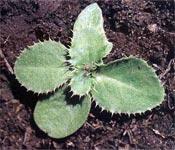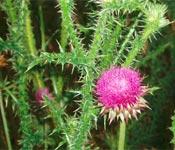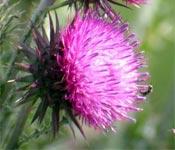Other Names – Musk Thistle
Family – Sunflower Asterceae
Life Cycle – biennial
Habitat – forage crops, hay fields, rangeland, roadsides, waste areas
Key Features
- Winged prickles along stem except below flower heads
- Large, nodding, purple flower heads
- Involucral bracts spine-tipped and bent backwards
Seedling
Cotyledons are oblong. The true leaves have irregularly lobed margins with spiny-tipped teeth. The leaves are light greyish-green and may be sparsely hairy.
Juvenile
Nodding thistle have a long, fleshy tap root and forms a large, flat rosette in the first year. The rosette leaves have deeply lobed, spiny margins. Stems elongate in the second year. They are usually sparsely branched and covered with winged prickles. Stem leaves are alternate and deeply lobed with spiny margins.
Mature
Large, showy flower heads are solitary at the ends of the branches. Unlike the rest of the plant, the stems are naked just below the flower heads. The disk flowers of the head are bright purple. Bracts around each flower head are in loose whorls with strong sharp spines at the tip. The outer bracts are bent backwards, and most of the heads tend to nod. The seeds are shiny yellow-brown with a white pappus of long, unbranched hairs. The spread of nodding thistle has been somewhat limited by the introduction of an insect (Rhinocyllus conicus – a flower weevil) that feeds on the developing seeds.
 |
 |
 |
